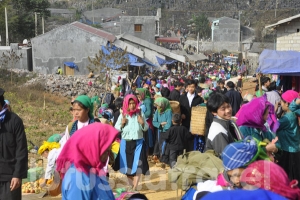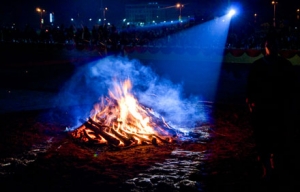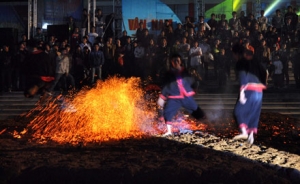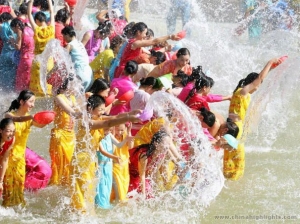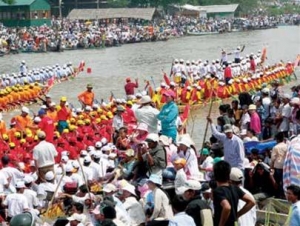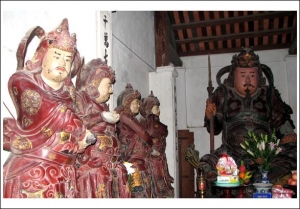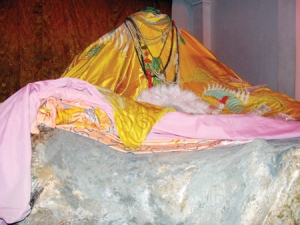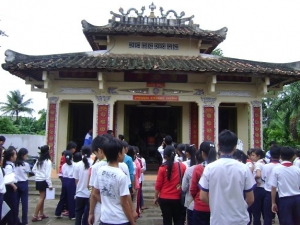
Asia Pacific Travel Team
Khau Vai Love Market Festival
The first day is for the ceremony to receive the great calendar. Moha Sang-Kran is considered a calendar which gives a detailed account of dates and festivals in a year and a forecast of rainfall so the villagers can foresee if they get a good or bad crop that year.
On this day, at a selected hour no matter it is in the morning or afternoon, people take a bath and put on their best clothes in anticipation of the New Year. They take incense, lamps, flowers and fruits to a pagoda where they do the great calendar-receiving ceremony. At the pagoda, Moha Sang-Kran, put on a red-lacquered, gilded tray, is placed on a palanquin and carried three times round the main sanctuary. This rite is to welcome the New Year and wait for omens for a bad or good new year. Then the official ceremony is carried out inside the sanctuary. After that, every participant prays to the Buddha and chant prayers for a happy new year. Young males and females walk out to the pagoda yard and join in fun activities until late at night.
The second day is for the ceremony to offer boiled rice and heap up a sandy mountain. On this day, every Khmer family cooks rice and offers it to Buddhist monks at the pagoda in early morning and at noon. The monks chant prayers to thank those who make the food and bring it to their pagoda and say good luck to them.
On the afternoon the same day, people start to heap up a sandy mountain in search of happiness and luck. They make small mountains looking to eight directions and one in the middle which represent the universe. This custom originates from an age-old legend. It displays people’s aspirations for rain.
The third day is for the ceremony to wash the Buddha’s statue and Buddhist monks. After giving boiled rice to the monks in the morning, they continue to listen to Buddhist teachings. In the afternoon, they burn incense, offer sacrifices and use scented water to wash the statue in order to pay tribute and gratitude to the Buddha. This is also to get rid of the old year’s misfortunes and wish all the best for the New Year. The monks do a ceremony to pray for peace in the death’s souls. After that, the people return to their house and wash the Buddha’s statue at home. They offer dishes, confectionery and fruits to ask for happiness for their parents and grandparents and being forgiven for their mistakes made in the old year.
During these three days, Khmer people go to visit each other and wish good health, good luck and prosperity to each other. They also join in fun activities.
Chol Chnam Thmay festival shows Khmer people’s aspirations, like many others ethnic groups, to forget about the old year’s misfortunes and look for a better new year.
Each year, there is a market session on lunar March 27 (often falling on solar May), but it is not a farming produce trading market but a love market. The name and activities of the market have common things with love market in Sapa.
But what’s different is that Khau Vai is a love market for various ethnic minority groups from four mountainous districts in Dong Van Plateau and ethnic minority groups in communes adjacent to Bao Lam and Bao Loc districts of Cao Bang province.
Local senior people said that this love market dated back to 1919. Roads are now more accessible than the previous years, so more people come to the market. However, activities of the market are still rich in cultural identity.
A local myth tells the story of a young couple from different tribes who fell in love with each other. The girls belonged to the Giay group and the boy belonged to the Nung group. The girl was so beautiful that her tribe did not want to let her get married with a man from another tribe. Consequently, violent conflict arose between the two tribes.
One day, the boy witnessed an aggressive fight between the tribes as a result of their love. To stop the blood shed, the lovers sorrowfully decided to say goodbye. However, they made plans to meet once a year on that day, lunar March 27.
The place where they used to meet is Khau Vai, which thereafter became a meeting place for all of those in love.
In the market area, there are two temples called Ong and Ba (Mr and Mrs). A story tells that, once upon a time, there was a boy and a girl born in two different places of the Dong Van Plateau. The boy’s surname is Linh and the girl’s surname is Loc. They love each other very much despite being hindered by deep streams and high rock mountains.
Because their families prevented their marriage, they together came to Khau Vai, a prosperous land with rich plants which they could live on.
Although they did not have a child but they lived happily until they died. In honor of their merits in cultivating the wild land into a rich land, the local people built the two temples to worship them.
Therefore, on every lunar March 27, Khau Vai attracts couples of different ages, including those who seek their partners for the first time. However, most of them are those who love each other very much but cannot wed together because of many different reasons.
On the day when the market session takes place, it is likely that both the wife and her husband together go to the market but they look for their own partners to share emotions. If one of them has to stay at home, he or she is not jealous in love because the dating at the marketplace is really a faithful feeling exchange.
It can be said that the beauty of love is a basic factor to keep the existence of Khau Vai love market for such a long time.
With the assistance of Ha Giang Culture and Information Department, Meo Vac district and Khau Vai commune authorities hold the traditional love market of Khau Vai in order to promote cultural identity of ethnic minority groups in the locality.
The love market festival is held on lunar March 26 and 27 with the participation of a large number of locals. The festival features food and drink culture, song performances and folk games. Ethnic costumes, jewellery, ethnic musical instruments and culture and art publications are on display at the market, reflecting activities of the local people.
Secretive tradition of fire dancing in Ha Giang Province
Fire dancing is one of the most thrilling traditional arts performed by young men in the northern province of Ha Giang. After the last harvest at the end of the year, young boys of the Pa Then Ethnic Minority Group in Bac Quang and Quang Binh Districts in Ha Giang Province hold a fire dancing ceremony to celebrate the new rice.
This is one of the most thrilling and unique ceremonies in the region.
To perform this dance, the young boys must follow a strict training programme which involves mysterious methods provided by a skilled elderly magician.
Before the performance, the young boys must, together with their trainer, prepare an offering to the ‘Fire God’ and the ‘Water God’ and worship for 2-4 hours. The offerings usually include a small incense burner, a boiled chicken, 10 cups of rice wine and wood.
They must do so to get an ‘ok’ from the gods that they can jump into the fire and perform their skilled moves.
The young dancers also eat the live, burning embers. Before and after the performance, they always take some to enjoy.
Women and small boys are not allowed to join in the tradition however, they will gather around to cheer them on.
The brave men will, on bare feet, jump and dance on a fire without being burnt.
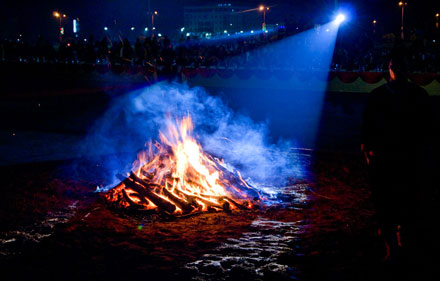
The fire is ready

The magician is helping young dancers prepare the offerings










Thrilling performances with the fire

Lying on the burning embers
Festivals of Con Son Pagoda honour ‘Great Man of Culture
Two festival seasons have been held annually in Con Son Pagoda in the Chi Linh District of the northern province of Hai Duong. The spring festival season originated on the 22nd day of the first lunar month in 1334 and marks the anniversary of the death of monk Huyen Quang, one of the founders of Truc Lam Zen Buddhism.
The autumn festival season begins on the 16th day of the eight lunar month, to mark the anniversary of the death of Nguyen Trai, a famous poet and politician during the Le Loi King in the 15th century. He wrote Binh Ngo Dai Cao, a declaration of freedom for the country.
The autumn festival was first held in 1962 and became an official national event in 1980 when Nguyen Trai was honoured as the Great Man of Culture by UNESCO.
Located 80km away from Ha Noi, Con Son Pagoda is known for its historic relics associated with the lives of many Vietnamese heroes and famous persons.
Tourists will be attracted to the charming mountains, rivers and forests that form the poetic and beautiful landscape.
Con Son Pagoda is one of three centres, Con Son, Yen Tu and Quynh Lam of Truc Lam Zen of the Tran dynasty in the 13th century. The pagoda was built between two mountain ranges, Phuong Hoang and Ky Lan, before the Tran dynasty and was restored and expanded under the Le dynasty in the 15th century.
Over the years Con Son Pagoda has become small and hidden under green trees. If tourists visit out of the festival seasons, they will find a very peaceful atmosphere.
Visitors will see many pine trees as they pass through the three-door gate and be fascinated by the old stone steles in the pagoda's ground. The one on the right was autographed by King Tran Due Tong (1337-77) when he visited in 1373.
There are about 385 statues in the pagoda. Buddhist nun Tue Tam said that "some statues were created according to the portrait of famous monks and mandarins".
During the French resistance war, the small statues and many objects for worship were hidden in the mountain.
According to the story, one night during a thunderstorm, the pagoda's master monk could not sleep and decided to visit the statues in the next morning. When he arrived, he saw that the two unknown statues had been broken open to reveal two life-preserving amulets. They were identified as the great national hero Nguyen Trai and his concubine Nguyen Thi Lo.
The pagoda was recognised as a national heritage in 1962 and was then recorded as an important relic worth preserving 32 years later in 1994.
Dang Minh Tower, built with blue stones at the grave site of Huyen Quang monk, stands behind the pagoda. At the foot of the tower rests Pearl Well.
A wide path with ancient pine trees growing on both sides and footsteps leading to the peak of Ky Lan Mountain lies behind the grave tower.
Legends say that on the full moon night of the seventh lunar month, monk Huyen Quang received an omen about a water source. He went to the mountain and found a well containing fresh, cool water. Since then, the water in Pearl Well has been offered during rituals at the pagoda.
From Con Son Pagoda, it's a 600-step climb up to the peak of Ky Lan Mountain. Bach Van (White Cloud) Shrine, where Nguyen Trai lived at the end of his life, is at the peak.
Next to the shrine is Ban Co Tien (fairy chessboard) and several other large flat stones called "immortal chessboards" by local residents. Local people were believed to have been travelling along the misty path to the peak when suddenly they heard human voices and laughter.
But all they found was a never-ending chessboard. They decided heavenly deities must have ridden clouds to Ky Lan Mountain to play chess.
The stone path down to the base of the mountain leads to Thach Ban (stone table), two large, smooth and flat rocks that sit beside the Con Son Spring. It is said that Nguyen Trai used to sit on these rocks to think and write poetry.
Next to Con Son Spring is a temple dedicated to Nguyen Trai that was built in 2000 and inaugurated in 2002 in celebration of his 600th birthday.
About 7km west of Con Son Pagoda in the valley of Rong Mountain is Kiep Bac Temple, the estate and garrisoning camp of Tran Hung Dao (1228-1300) after the first victory over the Yuan invaders in 1258. He was a brave general whose army defeated 500,000 Mongol invaders in the mid-1280s and he is now a revered Vietnamese folk hero.
Every year from the 15th to 20th day of the eighth lunar month, tens of thousands of people throughout the country attend the Kiep Bac Temple Festival.
The beautiful temple was built in 1300 where Tran Hung Dao is said to have died. It was built not only for the general, but also to honour other notabe members of his family.
Within the temple complex there's a small exhibition on Tran Hung Dao's exploits. The Tran Hung Dao Festival is held every year from the 18th to the 20th day of the eighth lunar month, which usually falls in October.
Con Son Pagoda and Kiep Bac Temple are two of three areas to be protected as special preserved areas in Hai Duong Province because of their cultural and historical significance, according to the chairwoman of the province, Nguyen Thi Minh.
The preservation plan needs an investment capital of VND1,600 billion, which will be mobilised from the local budget, tourism and economic sectors, Minh said.
Water Splashing Festival
At the time when Bo ma, a variety of wild flower that is used as an offering of the Thai ethnic people to Then (genies), and hundreds of varieties of wild flowers are in blossom and the area of Pu Nho Kho Mountain is full of festive atmosphere, Thai people in Khong Lao Commune, Phong Tho District, Lai Chau Province jubilantly prepare for several traditional festivals.
Probably the most observed festival is the Water Splashing Competition. Although nobody knows the exact origin of the festival, for the Thai ethnic people of Vietnam it is a gala that raises community harmony and spirit.
At the time when Bo ma, a variety of wild flower that is used as an offering of the Thai ethnic people to Then (genies), and hundreds of varieties of wild flowers are in blossom and the area of Pu Nho Kho Mountain is full of festive atmosphere, Thai people in Khong Lao Commune, Phong Tho District, Lai Chau Province jubilantly prepare for several traditional festivals. Probably the most
 observed festival is the Water Splashing Competition. Although nobody knows the exact origin of the festival, for the Thai ethnic people of Vietnam it is a gala that raises community harmony and spirit.
observed festival is the Water Splashing Competition. Although nobody knows the exact origin of the festival, for the Thai ethnic people of Vietnam it is a gala that raises community harmony and spirit.
The teams participating in the competition consist of the strongest men and women
from the hamlet with the hope of winning the prize.
The sorcerer offers Bo ma flowers to invite Then to participate in the competition with the villagers.
 Before the competitions, teams participate in catching fish in their traditional ways.
Before the competitions, teams participate in catching fish in their traditional ways.
The water splashing competition of Thai ethnic people in Nam Lum also attracts a large number of Dao people in Ma Ly Pho and Mong people in Dao San.
When the competition ends, teams often splash water from the stream, thought to be Then water, on audiences.
According to the Thai ethnic people, the village team winning the competition will have a bumper crop the following year.
The competition is held between numerous hamlets in the area and each hamlet has a team that includes both females and males. There is no limit to the
 number of players each team can have and the goal of the competition is to get the rival teams as wet as possible and not fall down. The Thai people believe that during this competition, the wetter they get, the more prosperous and luckier they will become.
number of players each team can have and the goal of the competition is to get the rival teams as wet as possible and not fall down. The Thai people believe that during this competition, the wetter they get, the more prosperous and luckier they will become.
The competition held at the sacred Lam Lum Stream (according to Thai folklore the stream was put there by genies), often attracts the participation of thousands of people who dress in their colourful traditional outfits. During the most solemn rite when the old men start praying, all participants seem to perceive the harmony of heaven and earth and have a strong belief that a bumper crop will follow the festival.
 Old artisan Lo Pau in Khong Lao Commune who plays a Tinh musical instrument at the Then festivals and ancient dance performances of the Thai people, said: “As usual, every year when the competition finishes, it often rains for 30 minutes.” According to their belief, the genies provide rain to nourish the fields and also join the splashing competition.
Old artisan Lo Pau in Khong Lao Commune who plays a Tinh musical instrument at the Then festivals and ancient dance performances of the Thai people, said: “As usual, every year when the competition finishes, it often rains for 30 minutes.” According to their belief, the genies provide rain to nourish the fields and also join the splashing competition.
The festival is the harmonious combination of spiritual desires and reality, bringing about happiness for each person. It is one of the unique festivals of Vietnamese ethnic people that need to be preserved and promoted.
(Source: Vietnam Pictorial)
OocOmBok Festival
Ooc-Om-Bok Festival is a religious service that worships the moon deity of the Khmer minority group and prays for good luck, happiness, good weather and bumper crops. The festival is usually held when the dry season begins and rice are ripening on the fields.
The Moon-worshiping ceremony takes place on the evening of 14th of tenth lunar month before the moon goes to the top. The ceremony is held in the yards of the pagoda or of residents’ houses. People erect bamboo poles with a crossbar on which they decorate with flowers and leaves. Below is a table of offerings that include green rice flakes, potatoes, bananas, coconuts, grapefruits, oranges and cakes. People sit on the ground with crossed legs, clasping their hands before the altar and look up the Moon. An old master of ceremonies says his prayers, asks the moon deity to receive the offerings and bless people with the best.
After the ceremony, the elders ask the children of the house sit flatly on the ground with crossed legs before the altar. The elders then take a handful of green rice, feed each child and ask them what they wish while clapping their backs. If the children answer the question clearly and politely, all the best will come to them that year. After that, people enjoy the offerings together, and children play games or dance and sing in the moonlight. Anyone who visits the Khmer’s houses on this occasion will be tasted com dep (a kind of young sticky rice). At the pagodas of Khmer people, locals hold paper-lantern releasing into the sky and putting on the rivers. The custom of releasing flying lights and floating lights is believed to sweep away the darkness, impure and sadness from the village. Many traditional activities of the Khmer are organized on the evening of 14th.
Thay Pagoda Festival
Thầy Village (nowadays called as Thụy Khê Village) is located at the foot of Sài Sơn Mountain, and belongs to Quốc Oai District, Hà Nội. The mountain has a number of old pagodas the most well known of which is the Thầy Pagoda where is also worshipped Từ Đạo Hạnh, a monk of the Lý Dynasty who hailed from Láng Village (Hà Nội) and was endowed with supernatural powers
Visitors come to this village all the year round for several reasons. The village and Sài Sơn Mountain provide well-known scenic sports involving a nice lake (Long Trì Lake) which has in the middle of it a big house fro viewing yearly water puppets shows and two wooden bridges with curved tiled roofs, and many beautiful mountain caves. The mountain also has, as its foot and on its slopes, a number of old pagodas the most well known of which is the Thầy Pagoda where is also worshiped Từ Đạo Hạnh, a monk of the Lý Dynasty who hailed from Láng Village (Hà Nội) and was endowed with supernatural powers.
Both the Thầy and Láng Pagodas Festivals are held in early March of each year, but differ from each other in terms of specific rites and ceremonies.
The Thầy Pagoda Festival is actually a joint festival of four villages (Thụy Khê, Đa Phúc, Khánh Tân and Sài Khê). While the whole area has many pagodas, the Festival is held mainly in Thiên Phúc Pagoda, alias Thầy Pagoda, which comprises three buildings: ante-chamber, Buddha’s Building, and the Building of the Genius. It is said that Từ Đạo Hạnh led a religious life and died in this very pagoda. At the end of his life, he sat in meditation for several months without food and drink and died in the process. Thereafter, the people put his withered corpse in the Building of the Genius for the purpose of worship. The Ming invaders who ruled over Việt Nam from 1407 to 1427, took Từ Đạo Hạnh’s corpse to a mount and burned it. Thereafter, the local population collected his ashes and mingled them with earth in order to make a statue for worship. From then on, the mount was called the Burning Mount.
Ceremonies connected with the Thầy Pagoda Festival started from March 5 to 9 (lunar year) and comprise: giving a bath to Từ Đạo Hạnh’s statue, presenting incense sticks, tablets escorting procession, folk theatrical plays (Chèo), chess games, water puppets show, recital of the feats of Từ Đạo Hạnh and more.

Thầy Pagoda,Quốc Oai District, Hà Nội
Two most noteworthy events and distinctive features of the festival are the procession of the tablets and the water show.
The procession of the tablets takes place on March 7, in which all the four villages take part. The local population believes that Từ Đạo Hạnh first learned supernatural powers and became a genius, and at later time, embraced Buddhism. Therefore at the start of the procession, his tablets must be wrapped in a piece of yellow cloth (the color of the robes worn by priest endowed with supernatural powers) and on the return trip the same tablets should be wrapped in the brown frock of a Buddhist monk. In the core of the procession, Buddhist nuns walk while recounting the feats of Từ Đạo Hạnh, first in learning supernatural magic and then in leading a religious as it is the time when night takes over from day, when darkness and night come into contact with each other. The order of the procession also has variations with specific significance. At the start of the procession, the tablet of the Spirit Protector and the Red Horse of Thụy Khê Village must come first, then follows the tablet of the Spirit Protector and the White Horse of Đa Phúc Village, then the tablet of the respective Spirit Protectors of Sài Khê and Khánh Tân Villages, and at the end comes the tablet of Từ Đạo Hạnh. The tablet of the Spirit Protector of each village is carried by people of the village concerned, while that of Từ Đạo Hạnh is carried by four persons appointed by the four villages. During the return trip, the tablet of the Spirit Protector and White Horse of Đa Phúc Village must come first, to be followed by the tablet of the Spirit Protector and the Red Horse of Thụy Khê Village, while the order with respect to the remaining components of the procession remains unchanged. The above change in the precedence of the Red and White horses is connected with a specific legend: When Từ Đạo Hạnh promised to reincarnate himself as the offspring of Marquis Sùng Hiền Hầu (younger brother of King Lý Nhân Tông) he told the Marquis: “When your wife is giving birth, you must notify me immediately so that I can perform the due rites.” As agreed, on that day, Sùng Hiền Hầu ordered some horsemen to rush to the Pagoda for this purpose. The Red Horse reached the pagoda first and brought in the news, while on the return trip to the White Horse outstripped the former and came home first.

Some Vajrayāna statues at the Thầy Pagoda
The second noteworthy item is the water puppet show, a traditional cultural activity related to wet paddy cultivation in the Red River Delta. This item comprises two basic components: puppets and water. The puppets are products of traditional popular wood sculptures and lacquer painting. The place for the puppet performance is lake or a part of the river. With its fluid nature and reflections, water can mirror efficiently the numerous changes in the color of the sky, the mountains, trees and leaves and give a mythical air to the performance. The artists must usually stay inside the water and direct the movement of the puppet through sticks and strings connected. Several festivals in various places do have water puppet shows but they are performed by professional groups coming from other localities and in improvised stages. But the Thầy Pagoda has a fixed and specialized stage – the big house in the middle of the Long Trì lake, also called the Dragon lake and the whole expanse of water – 15m long – from the house upto the bank of the lake which is much larger than the stage provided in other places, usually having a maximum length of 4 meters. The water puppet shows reflect either productive activities – paddy cultivation, duck breeding, fishing, cloth weaving, etc. - or games such as wrestling, unicorn dance or historical tales. The shows also draw from folk or classical theatrical plays.
The skits performed by the water puppets are usually shown, and silent (except for some occasional introductory remarks, and accompanying music, either folk or classical), but they reflect distinctly the life of population and their struggle against natural calamities and foreign invasions, for national development and defense. They fill the spectators with surprise and pleasure, and also pride in the rich imagination and dexterity of performers who created in this art. Indeed, the founder and teacher of the water puppet show is none other than Monk Từ Đạo Hạnh.
The Thầy Pagoda Festival is attractive to many because of the myth surrounding Monk Từ Đạo Hạnh and his feats, the beautiful scenery and the water puppet shows. Also, a romantic dimension must be added, as the labyrinth of caves and paths in the mountain are ideal for hide-and-seek games.
This is reflected in an old saying:
“The Thầy Pagoda area has the Cắc Cớ cave
“Young bachelors often remember it with nostalgia.”
Cổ Loa Festival
Cổ Loa is a commune belonging to Đông Anh, a suburban district of Hà Nội City. Starting from Hà Nội, we can reach the commune by going along Highway 1, crossing Chương Dương Bridge and then Cầu Đuống Bridge, and thereafter following Highway 3 for three kilometers. Getting there, one can see the remains of three layers of concentric ramparts built by King An Dương Vương, alias Thục Phán, in the second century BC
The legend of An Dương Vương – Mỵ Châu – Trọng Thủy:
In the second century BC, Việt Nam was a country named Âu Lạc ruled by King An Dương Vương whose name prior to coronation was Thục Phán. He had only one daughter, whose name was Mỵ Châu. The State’s capital was located at Cổ Loa where the King built a fortress and ramparts. Yet, whatever was built in the day was subsequently demolished at night by evil spirits. The King held a religious ceremony and begged Heavens for assistance. There upon, a golden tortoise came and gave guidance to the King on how to do away with the malfeasance of evil spirits. As a result, the fortress and ramparts could be completed. In biding farewell, the golden tortoise presented the King with one of its claws. The King turned the claw into the trigger of his crossbow, a single arrow of which could shoot thousands of enemy troops. The crossbow was thus called as the Magic Crossbow or Tortoise Crossbow.
By then, a rebel Chinese General, Zhao To, established in Southern China a Kingdom called Nam Việt. He tried to conquer Âu Lạc State, but his military adventures ended in failure because of the magic Crossbow. Resorting to a different strategy, Zhao To sought peace and requested Thục Phán to give consent to marriage between Trọng Thủy, Zhao To’s son, and Mỵ Châu, Thục Phán’s daughter. Thục Phán gave his agreement that Trọng Thủy could, as son-in-law, stay in Âu Lạc Kingdom in keeping with the practice of uxorilocality with bride service.
Taking advantage of his wife’s deep feeling of love and credulity, Trọng Thủy stole the secrets of the magic crossbow. Thereafter, he sought permission from Thục Phán to return home for visiting his parents. In departing, Trọng Thủy said to his wife, “In case war breaks out between our countries some time in the future, how can I find you?” His thoughtless wife replied, “I’ve got a coat made of goose feathers. I’ll take them out and scatter them wherever I go.”
Thereafter, Zhao To launched a new war of aggression against Âu Lạc. Being overconfident in his magic crossbow, Thục Phán did not make adequate defense preparation. When enemy troops surrounded the Cổ Loa Fortress, Thục Phán started his crossbow but found it useless. He had barely time to put his daughter on horseback and ride away at full gallop to the south. When he came near the sea coast, the golden tortoise appeared. The King asked “Oh, Golden Tortoise, why have I lost my Kingdom?” Immediately the Tortoise replied, “Your enemy is just behind you.” As the truth suddenly dawned on him, the King drew his sword and killed his daughter, and then followed the golden tortoise into the sea. The sea waves brought the corpse of Mỵ Châu to Cổ Loa, and when the villages brought it ashore it became a big stone which is still kept and worshipped in a small temple near an old banyan tree. Trọng Thủy also suffered from the loss of his wife. One day, he came to a well in front of the former palace of King An Dương Vương. As he saw the face of Mỵ Châu on the surface of the water of the well, he plunged into the well and died. The blood which poured from Mỵ Châu’s body into the sea - as the result of the cut from her father’s sword - was swallowed by oysters and shelves which subsequently produced peals. Popular imagination even went so far to assert that if the peals were washed in the water of the well where Trọng Thủy died, they would become much brighter.
Cổ Loa Festival
Every year, the 12 villages of Cổ Loa Commune join hands in organizing the festival, which usually begin on the 6th of the first lunar month.
Early on the morning of the first day of the first lunar month, 12 notables from each village come to the house of the chief notable in order to prepare for the procession which starts soon thereafter. Opening the procession is the music band, to be followed by the chief notable and the 12 village notables, and then the villagers who carry various offerings to King An Dương Vương.
A couple of stone horses, one red and one white with embroidered saddles, stand on both sides of the outside part of the gate of King An Dương Vương’s temple. The road leading from the gate to the temple is lined with wooden stands for flags and other objects of worship. The palanquins of the 12 villages are placed in accordance with a pre-arranged order.
For the occasion, the organizers put in front of the temple a big altar with a glass box containing two gold car rings and objects of worship. A smaller alter, containing the King’s arms – sword, crossbow and bronze arrows – is set in front of the bigger alter. Beyond it is a space where a number of red – rimmed mats are spread and where the notables and the population will carry out the religious ceremony.
When the procession reaches the temple, a miniature royal court, containing an incense burner, a stone tablet, and the funeral oration, are put in front of the two altars.
The chief notable offiates at the religious ceremony in honor of the God King, which is in terms of rites quite similar to other traditional ceremonies, amidst the sound of music from the band. The nobles are followed by inhabitants. All beg the King to bestow peace and prosperity to the villages.
The ceremony lasts until 1 or 2 PM, and is followed by a general procession, with the participation of all the 12 villages, in honor of the King.

Art performance at the Cổ Loa Festival
In front ranks of the procession are the flags, the Miniature Royal Court and the sacred weapons of the Temple. Then come the music band and the village notables clad in traditional Court uniforms and holding the weapons supposedly wielded by the King – sword, crossbow, and arrows.
Then come the notables and inhabitants of the pagoda hamlet and of each of the 12 villages, with their own palanquins, flags and music bands. It is quite a long procession, which proceeds at a slow space, amidst the sound of music, and stops regularly to burn a round of firecrackers. Starting from the temple of King An Dương Vương, the procession comes to the Trọng Thủy Well, and then to the village gate. There upon, more firecrackers are burned and the contingent which carries the Miniature Royal Court and the royal tablets go back to the temple while the notables and population of the twelve villages would carry on the procession to their respective hamlets.
The religious ceremony and the procession end on the same day, that is, the 6th of the first lunar month, while the festival goes on until the 15th of the same month, with various traditional games and activities:
- in the night, there are fireworks, Ca Trù songs, folk theatrical plays (chèo) and conventional theatrical play (tuồng).
- in the day, old men play chess and cards, old women perform rites and present offerings at the Pagoda, while young men and women, a children have their own games: wrestling, tugs-of-war, swing, rope climbing, martial arts, shooting from bows and crossbows, flags dancing, human chess (chess games in which human beings are used in place of traditional chess-men), cock-fighting, penny-pitching, rice-cooking contest etc. One ancient game, which consisted in continuous drum-bearing either by pairs of drums or a whole group of drums, is no longer played.
People from neighboring communes used to come in their numbers to Cổ Loa to participate in the festival, regarding it as a national festival and spring merry-making.
Welcoming the Lord Whale Festival
The festival of welcoming the Lord Whale or the cult of the Lord Whale is popular in many coastal localities from Ngang Pass to Ha Tien, Phu Quoc Island.
This constitutes one of the biggest festivals of the fishermen. Different names are given to this festival: the procession of the Whale's skeleton, the ceremony of praying for fish,
The death anniversary of the founder of jewelry
During the festival, goldsmiths from Ho Chi Minh City and Southern provinces gather to worship ancestor, exchange experiences as well as help each other to develop jewellery trades of the ancestral.
Time: The 7th to the 9th day of the second lunar month.
Place: Le Chau Congregation, 586 Tran Hung Dao, District 5, Ho Chi Minh City.
Objects of worship: The founder of jewelry. 
Characteristics: Ancestor's death anniversary.
The festival includes two rites: the sacrifices - offering ceremony to the ancestor on two first days, and the ceremony of sacrifices - offering to the tien hien, hau hien (sages of former time) on the last day. On the evening of the 7th day, a performance of cai luong (reformed Theatre) is performed by artists and goldsmiths. During the festival, goldsmiths from Ho Chi Minh City and Southern provinces gather to worship ancestor, exchange experiences as well as help each other to develop jewellery trades of the ancestral. Those who could not attend the anniversary may make offering to the ancestors at home, but only after the ancestor's death anniversary that held in Le Chau Congregation.
Phan Cong Hon Temple Festival
Phan Cong Hon who led the people of 18 hamlets of Betel Garden in an attack on the residence of District Chief in 1885. The death anniversary is held resembling the genie worshipping ceremony.
Time: The 25th day of the second lunar month.
Place: Ba Diem Commune, Hoc Mon District, Ho Chi Minh City. 
Objects of worship: Phan Cong Hon who led the people of 18 hamlets of Betel Garden in an attack on the residence of District Chief in 1885.
Characteristics: The death anniversary is held resembling the genie worshipping ceremony.
Every year, on the 25th day of the second lunar month, his kinship and the villagers of Ba Diem Commune organize the anniversary of his death at the temple as the genie worshipping ceremony. There are many people attend the festival to commemorate the hero who sacrificed his life to help the villagers escape from repression and arrestion, bring honour to the tradition of 18 hamlets of Betel Garden.


